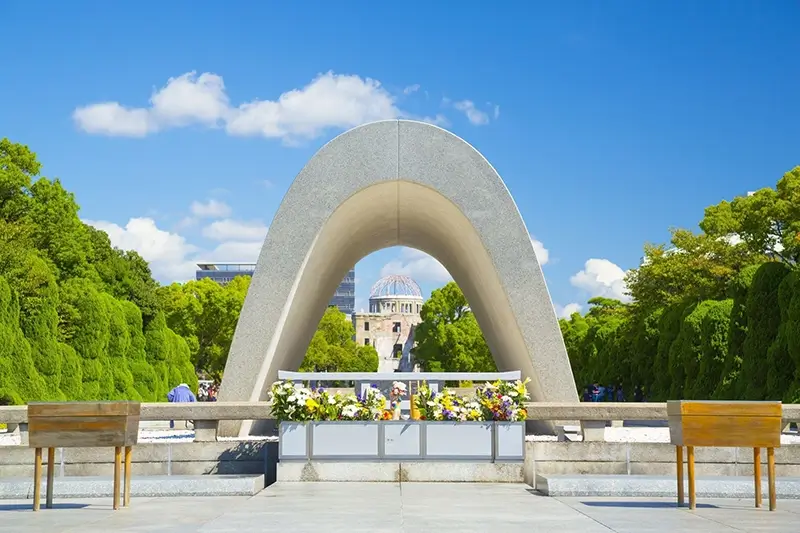
Hiroshima Peace Memorial Park isn’t just a place to visit—it’s a place to reflect. Built on the site most devastated by the atomic bombing in 1945, this park now stands as a symbol of hope, remembrance, and peace. Stretching across the heart of Hiroshima, the park is home to iconic landmarks like the Atomic Bomb Dome, Children’s Peace Monument, and the Peace Memorial Museum.
Visitors from around the world come here not only to learn about the past, but to imagine a future without war. Whether it’s your first time in Japan or you’ve visited before, walking through this park will leave a lasting impression.
Want to visit the Peace Park, Museum, and even nearby Miyajima in one smooth trip? Check out our guided tours for a deeper, more meaningful Hiroshima experience.
Why Is Hiroshima Peace Memorial Park Famous?
Hiroshima Peace Memorial Park is world-renowned as a space dedicated to remembrance and peace. It was built directly on the hypocenter of the atomic bombing that destroyed Hiroshima on August 6, 1945, and has since become a global symbol of the hope for a world free from nuclear weapons.
Designed by architect Kenzo Tange, the park was completed in 1954 and deliberately kept free of commercial development. Instead, it features memorials, trees, and quiet paths—a space to grieve, reflect, and learn.
Key events like the annual Peace Memorial Ceremony on August 6th, and school trips from all over Japan and abroad, highlight the park’s role in educating future generations. It’s not just a tourist destination—it’s a place of pilgrimage for peace.
Is the Hiroshima Peace Museum Worth Visiting?
Yes—absolutely. The Hiroshima Peace Memorial Museum is widely regarded as one of the most powerful and important museums in Japan. Its exhibitions cover the history leading up to the bombing, the human cost of the atomic bomb, and Hiroshima’s recovery. What makes it unforgettable are the personal stories—photos, burned clothing, watches stopped at 8:15, and handwritten notes left behind by victims.
Multilingual audio guides are available, and the exhibits are designed to be informative without being graphic. While emotionally intense, the museum is not meant to shock—it’s meant to educate, to inspire reflection, and to help ensure history is never repeated.
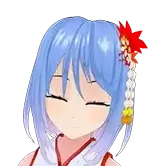
I spent over an hour inside the museum, but I kept going back to one exhibit—a watch stopped at 8:15. Something about that moment frozen in time made everything real. I left in silence, carrying the weight of those memories with me.
Do You Need Tickets for the Park?
No tickets are required to enter Hiroshima Peace Memorial Park—the park grounds are completely free and open to the public, 24 hours a day. You can walk freely around the Atomic Bomb Dome, Cenotaph, Peace Flame, and various monuments without any charge.
However, admission is required for the Peace Memorial Museum:
- Adults: ¥200
- High school students and younger: ¥100
- Children under 6: Free Multilingual audio guides are available for a small additional fee.
If you’re looking to go deeper, guided walking tours of the park are available and highly recommended. These tours often include context, translation, and personal stories that make the visit more meaningful.
Can You Still See the Shadows of People in Hiroshima?
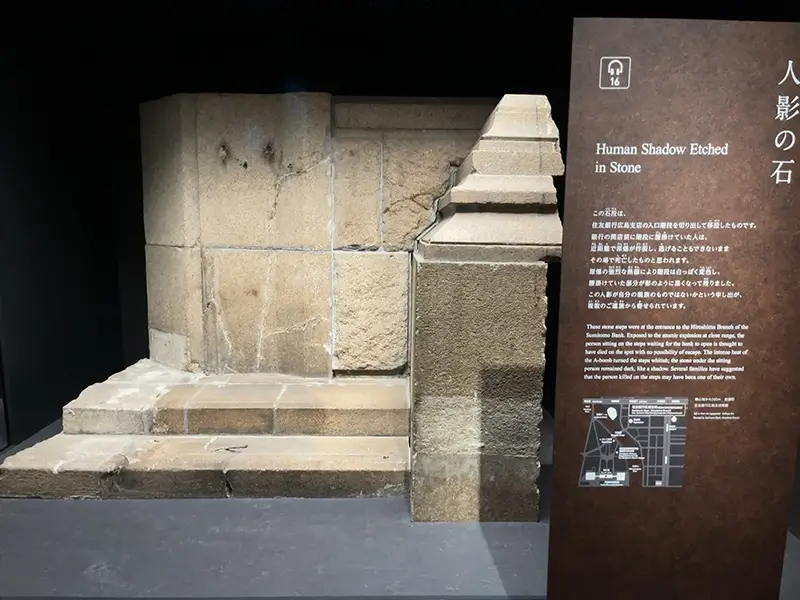
Yes—but not in the way some imagine.
You may have heard of “human shadows” left behind by the intense flash of the atomic bomb. One of the most famous examples is the “Shadow on the Steps”, found on stone steps near the Hiroshima Branch of Sumitomo Bank.
This shadow was created by the thermal rays of the bomb, which bleached the surrounding stone, leaving a darker patch where someone had been sitting. The person’s body absorbed the heat, blocking the rays, and creating a contrast in color. The actual stone was preserved and is now displayed inside the Hiroshima Peace Memorial Museum. So while you can’t see shadows in the open air anymore, you can view preserved examples and replicas that tell these haunting stories.
What to See Inside the Peace Park
Atomic Bomb Dome
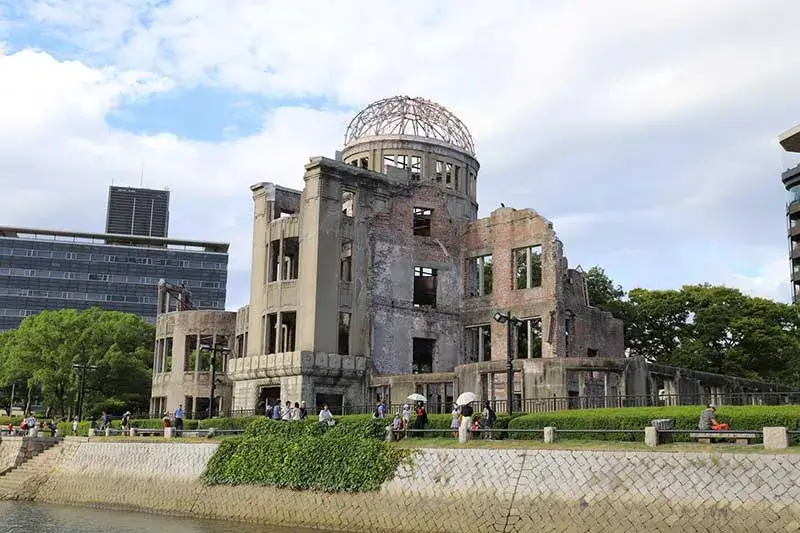
The park’s most iconic structure, preserved just as it was after the bombing.
It stands as a powerful reminder of what was lost—and what must never be repeated.
Peace Flame
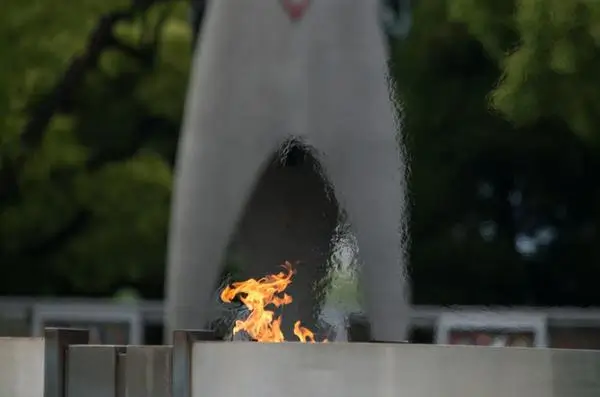
This flame has burned continuously since 1964 and will remain lit until all nuclear weapons are abolished.
It’s positioned along the main path, in line with the Cenotaph and Dome.
Children’s Peace Monument
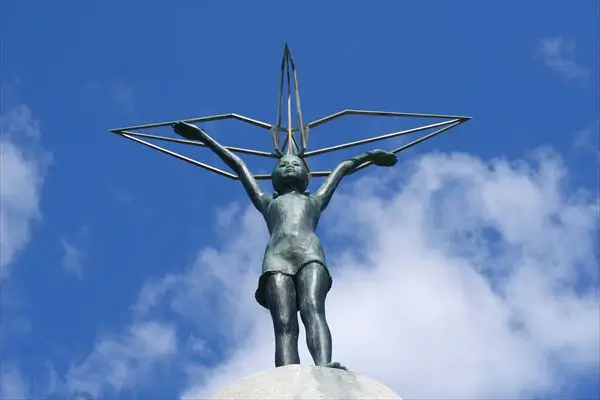
Dedicated to Sadako Sasaki and the thousands of children who died in the bombing.
Surrounded by bright origami cranes from around the world, it’s a deeply moving symbol of innocence and global solidarity.
Memorial Cenotaph

This arched stone monument contains the names of all known victims of the bombing.
Through the arch, you can see both the Flame and the Dome, perfectly aligned.
Access – Hiroshima Peace Memorial Park
Hiroshima Peace Memorial Park is located in the heart of Hiroshima City, between the Ōta and Motoyasu Rivers.
How to Get There
From Hiroshima Station, take tram Line 2 or 6 bound for Miyajima-guchi or Eba.
→Get off at Genbaku Dome-mae stop.
→The north entrance of the park is right in front of you. (The ride takes about 20 minutes.)
Visitor Info – Hiroshima Peace Memorial Park
Location
Central Hiroshima, near the Atomic Bomb Dome, surrounded by rivers and easily accessible on foot from most city attractions.
Opening Hours & Admission
Peace Park Grounds
• Open 24/7
• Free to enter
Peace Memorial Museum
• Hours: 8:30 AM – 6:00 PM (open until 7:00 PM in summer)
• Closed: December 30–31
• Admission:
• ¥200 (adults)
• ¥100 (students)
• Free for children under 6
Languages & Accessibility
• English signage available throughout the park
• Multilingual audio guides at the museum
• Wheelchair-accessible paths and elevators in all major facilities
Last updated: December 2025